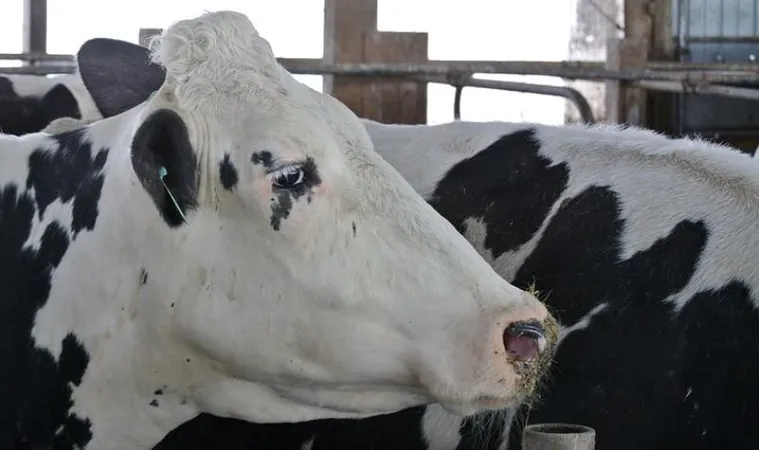
Alarming Gaps in Global Avian Flu Control for Mammals: Are We Ignoring a Looming Pandemic?
2024-09-25
A recent review by a team of virologists from the UK's influential Pirbright Institute has raised serious concerns about the effectiveness of global strategies aimed at controlling the transmission of avian flu among mammals. This troubling analysis, published in the esteemed journal Nature, highlights an alarming risk posed to humans as the H5N1 virus establishes a foothold in regions such as Europe and the Americas.
A Closer Look at the Threat
The scientists meticulously investigated outbreaks across various species, focusing on European fur farms, marine mammals in South America, and dairy cattle across the United States. Their findings underscore the increasing complexity of the avian flu's impact on both wild and domestic species. Notably, the researchers documented notable ecological changes and molecular evolution of the H5N1 virus that raise concerns about the potential for spillover into diverse mammalian populations.
Current Outbreaks and Unanswered Questions
This study comes at a critical juncture, as the U.S. faces ongoing H5N1 outbreaks among dairy cattle. Health officials in Missouri are actively investigating a puzzling human case with no traceable links to animal exposure or raw milk, casting a shadow of uncertainty over the virus's behavior and transmission pathways.
Dr. Tom Peacock, lead author and expert on zoonotic influenza, emphasized the historic role of influenza A viruses in causing pandemics, with pigs traditionally recognized as intermediary hosts. However, he warns that the evolving nature of H5N1 has introduced new avenues for potential transmission to humans.
Weaknesses in Control Measures
The review identified significant shortcomings in current control measures, particularly related to vaccination efforts and surveillance practices. There is a concerning lack of data about H5N1 transmission on dairy farms, complicating researchers' and policymakers' ability to respond effectively. Unlike the swift data-sharing that quelled foot-and-mouth disease outbreaks, information on the spread of H5N1 seems scant and delayed.
While H5N1 is classified as a reportable disease in poultry, it lacks equivalent status for mammals in the U.S., leading to an alarming gap in proactive testing among cattle. Very few states are engaged in bulk-tank testing for the virus, leaving a glaring void in our understanding of its potential spread.
A Hidden Crisis in Wildlife
The team also highlighted the deficiencies in wildlife testing methods, which predominantly revolve around monitoring deceased animals. By shifting the focus to live wildlife testing, authorities could unveil hidden transmissions that are occurring unnoticed.
"Scientists are particularly worried about the possibility of silent transmission chains," the authors noted, underscoring the urgent need for improved surveillance in settings such as poultry farms and areas with limited resources and oversight.
What If It Spreads to Humans?
If the H5N1 virus shifts to more readily spread among humans, the implications could be severe. Surprisingly, recent cases have exhibited much lower case-fatality rates, with symptoms primarily affecting the eyes—a stark contrast to earlier strains that held a grim mortality rate. There’s speculation that older populations may possess some immunity due to previous exposure to related viruses, while younger individuals—born after the 1968 H3N2 flu pandemic—might be especially vulnerable.
Conclusion: Is the World Prepared?
The ongoing developments in avian flu among mammals necessitate immediate attention and action from health authorities worldwide. The potential for a new pandemic looms, and our current strategies may not be equipped to handle this evolving threat. The world must unite to enhance monitoring, implement advanced vaccination programs, and commit to transparency in data sharing to prevent a potential public health catastrophe. The question remains: will we take these warnings seriously before it's too late?




 Brasil (PT)
Brasil (PT)
 Canada (EN)
Canada (EN)
 Chile (ES)
Chile (ES)
 España (ES)
España (ES)
 France (FR)
France (FR)
 Hong Kong (EN)
Hong Kong (EN)
 Italia (IT)
Italia (IT)
 日本 (JA)
日本 (JA)
 Magyarország (HU)
Magyarország (HU)
 Norge (NO)
Norge (NO)
 Polska (PL)
Polska (PL)
 Schweiz (DE)
Schweiz (DE)
 Singapore (EN)
Singapore (EN)
 Sverige (SV)
Sverige (SV)
 Suomi (FI)
Suomi (FI)
 Türkiye (TR)
Türkiye (TR)